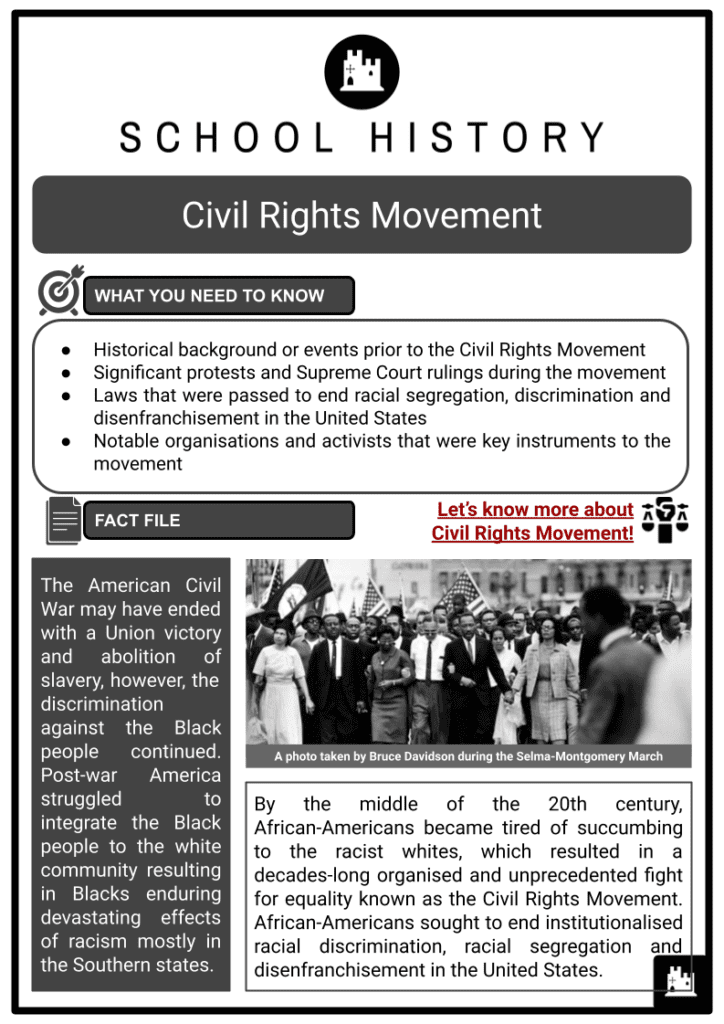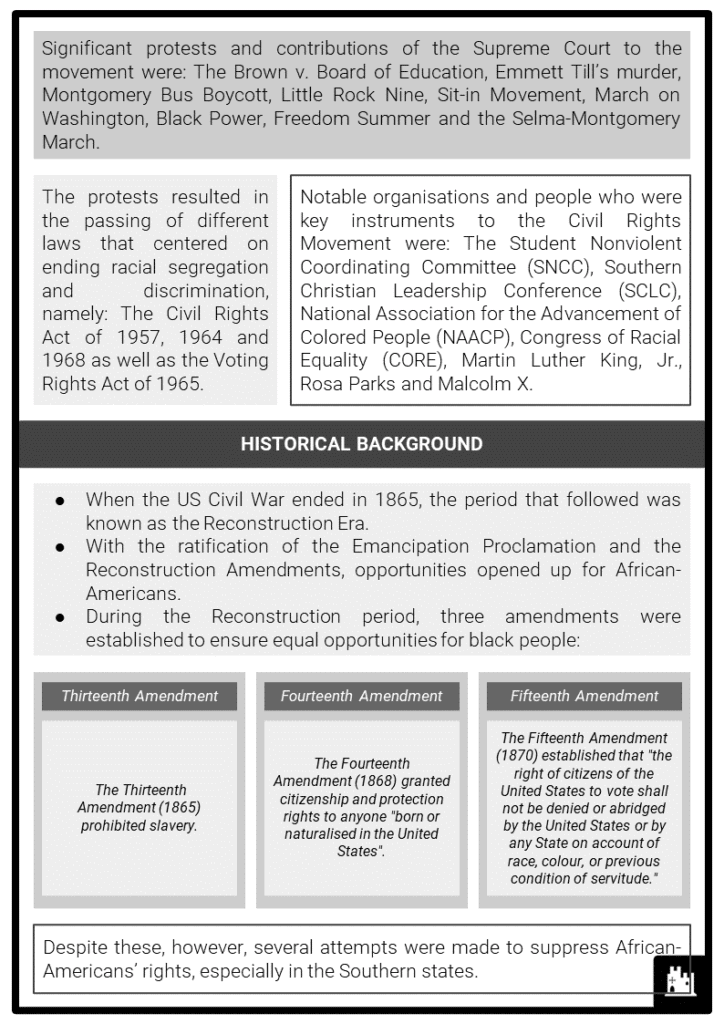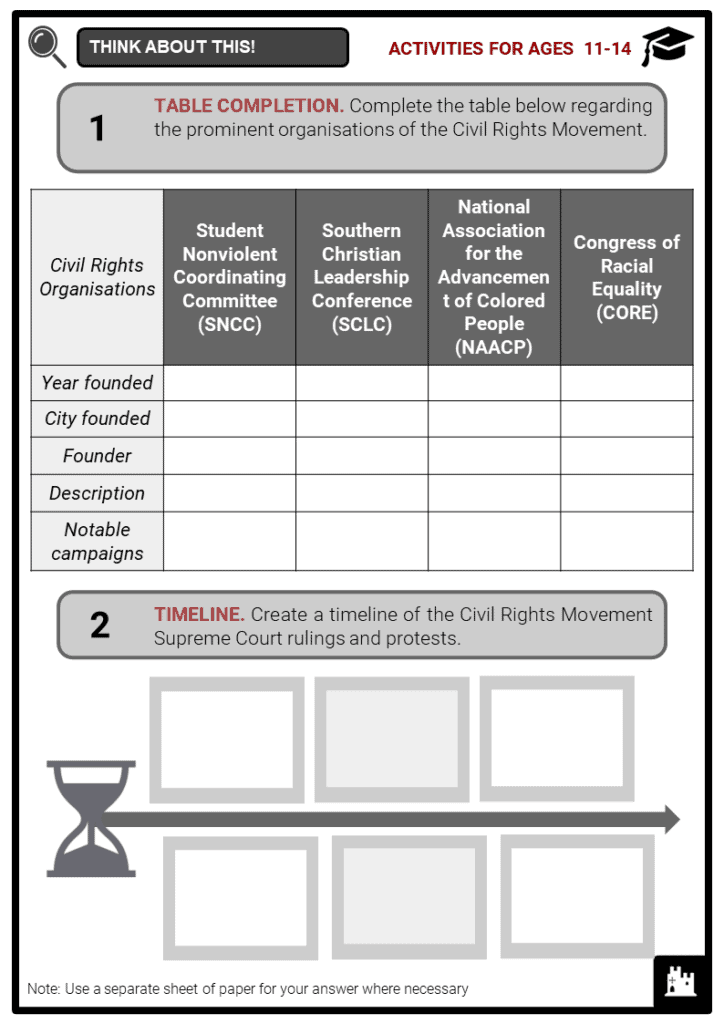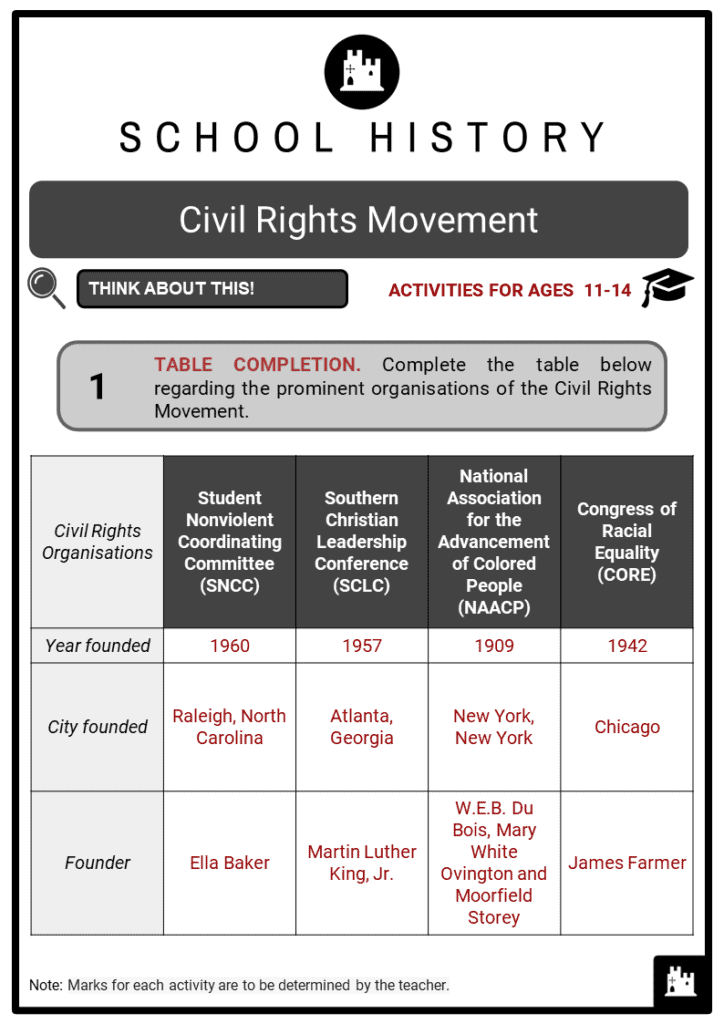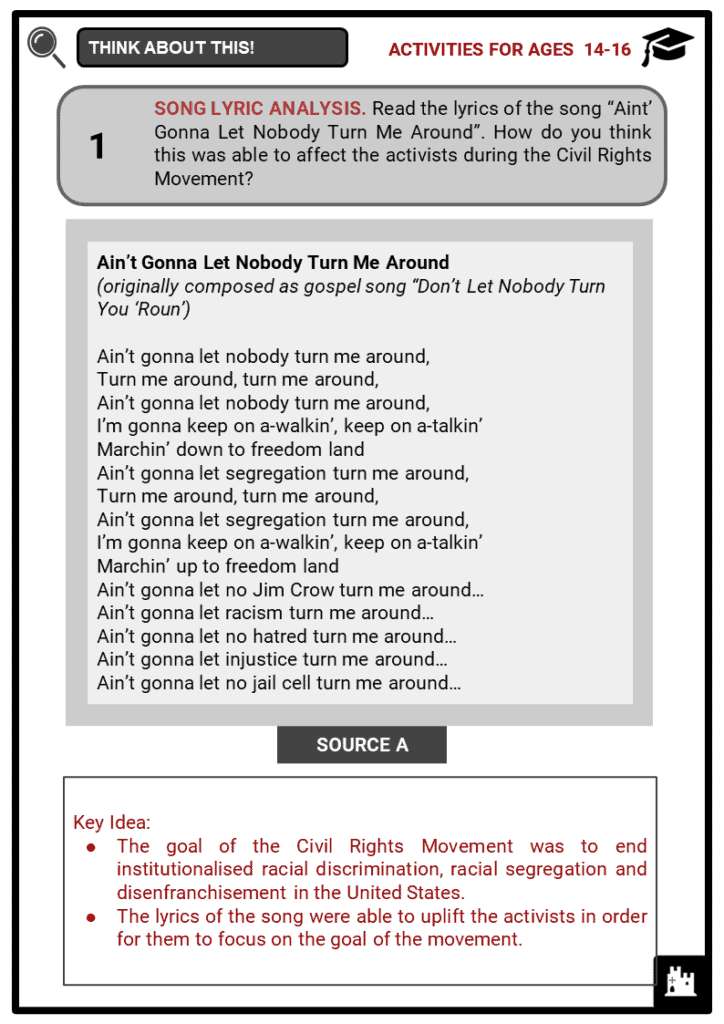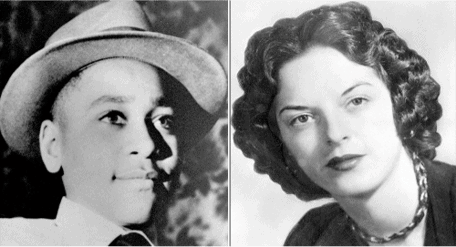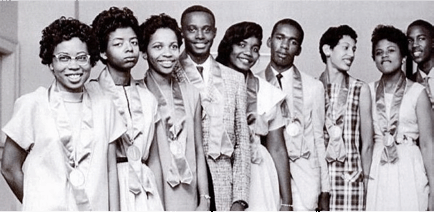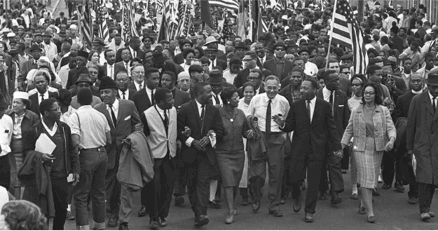Download Civil Rights Movement Worksheets
Do you want to save dozens of hours in time? Get your evenings and weekends back? Be able to teach Civil Rights Movement to your students?
Our worksheet bundle includes a fact file and printable worksheets and student activities. Perfect for both the classroom and homeschooling!
Table of Contents
Add a header to begin generating the table of contents
Summary
- Historical background or events prior to the Civil Rights Movement
- Significant protests and Supreme Court rulings during the movement
- Laws that were passed to end racial segregation, discrimination and disenfranchisement in the United States
- Notable organisations and activists that were key instruments to the movement
Key Facts And Information
Let’s know more about Civil Rights Movement!
- The American Civil War may have ended with a Union victory and abolition of slavery, however, the discrimination against the Black people continued. Post-war America struggled to integrate Black people into the white community, resulting in Blacks enduring devastating effects of racism mostly in the Southern states.
- By the middle of the 20th century, African-Americans became tired of succumbing to the racist whites, which resulted in a decades-long organised and unprecedented fight for equality known as the Civil Rights Movement. African-Americans sought to end institutionalised racial discrimination, racial segregation and disenfranchisement in the United States.
- Significant protests and contributions of the Supreme Court to the movement were: The Brown v. Board of Education, Emmett Till’s murder, Montgomery Bus Boycott, Little Rock Nine, Sit-in Movement, March on Washington, Black Power, Freedom Summer and the Selma-Montgomery March.
- The protests resulted in the passing of different laws that centred on ending racial segregation and discrimination, namely: The Civil Rights Act of 1957, 1964 and 1968 as well as the Voting Rights Act of 1965.
- Notable organisations and people who were key instruments to the Civil Rights Movement were: The Student Nonviolent Coordinating Committee (SNCC), Southern Christian Leadership Conference (SCLC), National Association for the Advancement of Colored People (NAACP), Congress of Racial Equality (CORE), Martin Luther King, Jr., Rosa Parks and Malcolm X.
Historical Background
- When the US Civil War ended in 1865, the period that followed was known as the Reconstruction Era.
- With the ratification of the Emancipation Proclamation and the Reconstruction Amendments, opportunities opened up for African-Americans.
- During the Reconstruction period, three amendments were established to ensure equal opportunities for Black people:
- Thirteenth Amendment - The Thirteenth Amendment (1865) prohibited slavery.
- Fourteenth Amendment - The Fourteenth Amendment (1868) granted citizenship and protection rights to anyone "born or naturalised in the United States".
- Fifteenth Amendment - The Fifteenth Amendment (1870) established that "the right of citizens of the United States to vote shall not be denied or abridged by the United States or by any State on account of race, colour, or previous condition of servitude."
- Despite these, however, several attempts were made to suppress African-Americans’ rights, especially in the Southern states.
- By the 1870s, the Jim Crow Laws were enacted in Southern states, mandating racial segregation in public facilities until 1965.
- This cemented racial discrimination and favoured white people over Black people.
- White supremacy became observable in terms of unequal work opportunities and in government, schools, churches and hospitals, to name just a few.
- The Jim Crow Laws were named after "Jump Jim Crow", a song and dance popularised in 1832 featuring a Black male caricature performed by a white actor, Thomas D. Rice.
- The aim of the Civil Rights Movement was to ensure constitutional and legal rights for African-Americans after decades of discrimination.
- During the Reconstruction period, several organisations were established to fight against segregation and discrimination.
- It reached its peak in the 1960s, when protests and mass civil disobedience campaigns were organised.
Supreme Court Rulings And Protests
1954 Brown v. Board of Education
- In 1951, Oliver Brown filed a lawsuit against the Board of Education of Topeka when his daughter, Linda Brown, was refused admittance to the public school closest to their home and required to attend an all-black school further from their home.
- Brown claimed segregation in schools violated the Fourteenth Amendment's “equal protection clause”.
- Several cases with similar lawsuits were combined with them and the district court ruled in favour of the school board based on the 1896 Plessy v. Ferguson case.
- The Brown v. Board of Education case was forwarded to the US Supreme Court, which overruled the Plessy v. Ferguson case stating that the "separate but equal" doctrine was unconstitutional for US public educational institutions.
- The case set a precedent to end racial segregation in public facilities and strengthened civil rights organisations.
- The Plessy v. Ferguson case was a landmark decision of the US Supreme Court in 1896 that stipulated that segregation in facilities were valid as long as they followed the doctrine of "separate but equal".
- On 17 May 1954, the US Supreme Court ruled that racial segregation in public schools was unconstitutional through the landmark case Brown v. Board of Education of Topeka.
- By May 1955, the Supreme Court issued lower federal courts, district courts and school boards to desegregate “with all deliberate speed.”
1955 Emmett Till’s murder
- On 28 August 1955, fourteen-year-old Emmett Till was murdered by lynching in Mississippi. He was accused of sexually harassing a white woman, Carolyn Bryant.
- Emmett Till was originally from Chicago but he went to Money, Mississippi in August 1955 to visit his relatives. On 24 August, Emmet bragged to his friends and cousins that he had a white girlfriend in Chicago while standing outside a small grocery store.
- Not believing him, his friends dared him to talk to twenty-one-year-old Carolyn Bryant who was sitting behind the store's counter.
- Emmett bought candy and on his way out was heard saying "bye, woman."
- When Roy Bryant, Carolyn's husband, heard of the incident, he went to Emmett's great-uncle's house and abducted him.
- Together with his half-brother, J.W. Milam made Emmett carry a 70-pound (32 kg) cotton-gin fan to the bank of the Tallahatchie River and ordered him to take off his clothes.
- They beat him and mutilated his body by gouging his eye out, and then shot him in the head.
- They threw his body, which was tied to the cotton gin with barbed wire, into the river.
- In September 1955, Roy Bryant and J.W. Milam went on trial in Sumner, Mississippi.
- Carolyn Bryant claimed that Emmet made physical advances and wolf-whistled at her.
- By 23 September, the all-white jury issued a "not guilty" verdict for Bryant and Milam stating that the state failed to prove the identity of the body.
- An African-American magazine, Jet, published photos of Emmet's body resulting in nationwide awareness of the brutality of racism.
- In a 2008 interview, Carolyn claimed that she fabricated her testimony.
1955–1956 Rosa Parks and the Montgomery bus boycott
- On 1 December 1955, in Montgomery, Alabama, Rosa Parks sat in the front row of the 'coloured section' as per the city ordinance of racial segregation.
- As the 'white section' was full, bus driver James F. Blake ordered African-Americans in the front row to vacate their seats.
- Parks refused and she was arrested and fined 10 USD plus 4 USD for court fees.
- The incident inspired a massive boycott from African-Americans in Montgomery wherein they refused to ride city buses in protest of segregation.
- It took place from 5 December 1955 until 20 December 1956.
- Many notable persons participated in the boycott including Martin Luther King, Jr.
- By 5 June 1956, the Montgomery federal court ruled that racial segregation on buses violated the Fourteenth Amendment of the US Constitution.
- On 21 December 1956, the boycott ended as the Supreme Court's decision was given by 20 December.
1957 Little Rock Nine
- After the historic success of the Brown v. Board of Education of Topeka case, racial segregation in schools was deemed unconstitutional.
- However, in Little Rock Central High School in Arkansas, Governor Orval Faubus ordered the Arkansas National Guard to block the nine (9) black students from entering the school on 4 September 1957 - the first day of classes.
- President Dwight D. Eisenhower intervened by issuing Executive Order 10730 in which National Guardsmen should support the school integration on 23 September 1957 by protecting the African-American students known as the Little Rock Nine.
- Ernest Green, a senior among the nine students, graduated on 25 May 1958, the first African-American student to do so.
- The Little Rock Nine were: Melba Pattillo Beals, Minnijean Brown, Elizabeth Eckford, Ernest Green, Gloria Ray Karlmark, Carlotta Walls LaNier, Thelma Mothershed, Terrence Roberts and Jefferson Thomas
1960 Woolworth’s Lunch Counter and the Sit-in Movement
- On 1 February 1960, four Agricultural and Technical College of North Carolina freshmen began a sit-in movement where they sat at the “whites only” lunch counter at the Greensboro Woolworth store.
- According to the Jim Crow Laws, they were refused service and asked to leave.
- However, they remained seated until closing time and returned the next day bringing more African-American students.
- Whenever the protesters were arrested, to continue the movement, new protesters took their place.
- The sit-in became widespread and soon enough became a movement as protesters took every seat in stores.
- After months of protests, desegregation of facilities began throughout the country and by July, Greensboro Woolworth started to serve African-American patrons.
1963 Martin Luther King, Jr. and March on Washington
- Martin Luther King, Jr. was a Baptist minister and social activist who led many momentous events in the American Civil Rights Movement in the mid-1950s.
- He believed in peaceful protest to dismantle social injustice against African-Americans.
- With religious groups and civil rights activists, King organised the March on Washington in 1963, a political rally highlighting equal jobs and freedom for African-Americans.
- About 250,000 individuals gathered on the National Mall in Washington, D.C. for the rally where they got to listen to speeches by civil rights leaders. The most notable of the speeches was King’s eloquent and uplifting message in “I Have a Dream”.
1964 Malcolm X and Black Power
- Born on 19 May 1925, Malcolm was a minister and Black nationalist leader who propagated the philosophy of the Nation of Islam in the 1950s and 1960s.
- He promoted freedom for African-Americans from racism by all means including violence.
- Malcolm X was known for having militant views including the establishment of an independent Black nation through violent revolution.
- The Black Power movement was a political and social movement that emerged in the 1960s which advocated autonomy and self-determination of African-Americans in the United States.
- Aside from its political cornerstone, and based on the influence of Malcolm X, the movement specifically introduced changes to African-American culture from hairstyles, clothing, music, art and even language use.
- The movement emerged as many African-Americans were dissatisfied with Martin Luther King, Jr’s slow nonviolent protests.
- King heavily denounced the movement as it encouraged and incited violence among young African-Americans.
- The movement ended in the late 1960s, as America’s focus turned to the Vietnam War.
1964 Freedom Summer
- By 1964, the Civil Rights Movement was increasing tremendously. Despite the efforts, however, the South remained segregated especially in regard to voting rights where poll taxes and literacy tests were designed to silence Black voters.
- Freedom Summer, also called Mississippi Summer Project, was a voter registration drive in 1964 with a goal to increase registered Black voters in Mississippi.
- The movement was organised by civil rights organisations, namely the Congress on Racial Equality (CORE) and the Student Non-Violent Coordinating Committee (SNCC).
- Despite the good cause to achieve equality, the Freedom Summer volunteers were violently attacked by white supremacist group Ku Klux Klan as well as state and local law enforcements.
- As the attacks were covered all throughout the media, awareness over civil rights was increased enabling the Civil Rights Act of 1964 and the Voting Rights Act of 1965 to be passed into law.
1965 Selma-Montgomery March
- On 7 March 1965, Martin Luther King Jr. organised the Selma-Montgomery March to call for a federal voting rights law.
- This law would subsequently provide legal support for disenfranchised African-Americans.
- As marchers flocked to the road for the protest, state troopers struck back with violence and tear gas.
- The media was able to record the incident which helped King to organise another protest 2 days after that led to the participation of more than 2,000 people.
- The media attention that the protest got allowed President Johnson to introduce voting rights legislation on 15 March.
- On 21 March, another protest led by King was held. This group of protesters marched out of Selma and were protected by federal marshals, FBI agents and Alabama National Guardsmen.
- They arrived in Montgomery on 25 March where King addressed the crowd through his “How Long, Not Long” speech. Soon enough, the events of the march led to the passing of the Voting Rights Act on 6 August.
The Acts
Civil Rights Act of 1957
- On 9 September 1957, the Civil Rights Act of 1957 was enacted, as proposed by President Eisenhower in Congress.
- It established the Civil Rights Section of the Justice Department and strengthened the federal voting rights bill as per the Fifteenth Amendment of the US Constitution.
- Its objective was not to create rights, but to protect the ones that already existed.
Civil Rights Act of 1964
- As proposed by John F. Kennedy, the Civil Rights Act was signed into law by US President Lyndon B. Johnson, which ended racial segregation in public places as well as banned employment discrimination based on religion, sex, colour and race.
- Under the 1964 Civil Rights Act, African-Americans as a minority should not be segregated and discriminated against in any public places including parks, theatres, restaurants, courthouses and others.
- They should not be denied any services based on colour or race.
- Moreover, the act also appropriated sufficient funds for anti-discriminatory programmes especially in assisting school desegregation.
- The passing into law of the Civil Rights Act had substantial impact on Black people in America.
- It was able to abolish the racial and religious segregations in schools and public places, ban discrimination based on the race, gender and religion in the workplace, protect voting rights of African-Americans, create the Equal Employment Opportunity Commission, and usher the Voting Rights Act of 1965 as well as the Civil Rights Act of 1968.
Voting Rights Act of 1965
- Before the final march to Selma-Montgomery, President Lyndon B. Johnson delivered a televised speech to support the voting rights bill. He stated that:
- “Their cause must be our cause too. Because it is not just Negroes, but really it is all of us, who must overcome the crippling legacy of bigotry and injustice. And we shall overcome.”
- With this, on 6 August, Johnson signed the Voting Rights Act of 1965 which enabled the suspension of literacy tests, poll taxes and other practices that had prevented Black people from voting.
- Within months, there were over 250,000 new registered Black voters. This increased even more in the following years.
- The Voting Rights Act of 1965 was not only able to give equal voting rights to Blacks, but it was also able to change the political landscape of the South as African-Americans held elective offices, gathering top positions in city, county and state governments throughout the years to come.
Civil Rights Act of 1968
- The Civil Rights Act of 1968, also known as the Fair Housing Act, prohibited discrimination regarding the sale, renta, and financing of housing based on sex, race, colour and religion.
- The act enabled people to rent or own houses in previously segregated areas.
- The Fair Housing Act was passed by Congress days after the assassination of civil rights leader, Martin Luther King, Jr.
- Prior to this act, race-based housing patterns were prominent in many areas, especially in the South.
- Amongst the impact of this act was the staggering increase of the African-American population in urban centres.
- The number rose from about 6.1 million in the 1950s to 15.3 million in 1980.
- As a result of the booming African-American population in urban areas, white Americans began to move from the cities to the suburbs.
- Ghettos began to emerge as inner city communities were dominated by poor African-Americans.
Prominent Civil Rights Activists
- “I have a dream that my four little children will one day live in a nation where they will not be judged by the color of their skin, but by the content of their character.” - Martin Luther King Jr.
- “Nobody can give you freedom. Nobody can give you equality or justice or anything. If you’re a man, you take it.” - Malcolm X
- “People always say that I didn't give up my seat because I was tired, but that isn't true. I was not tired physically... No, the only tired I was, was tired of giving in.” - Rosa Parks
Image sources:
- https://unitedgangs.com/wp-content/uploads/2017/01/emmett-till.jpg
- https://bakeramber1.files.wordpress.com/2013/03/little-rock-nine.jpg
- https://www.gannett-cdn.com/-mm-/dd2040790d03af2b197b02d9fee9eb13729190f4/c=0-92-1790-1099/local/-/media/Montgomery/2015/03/01/B9316206437Z.1_20150301013352_000_G059UEA5G.1-0.jpg?width=3200&height=1680&fit=crop

